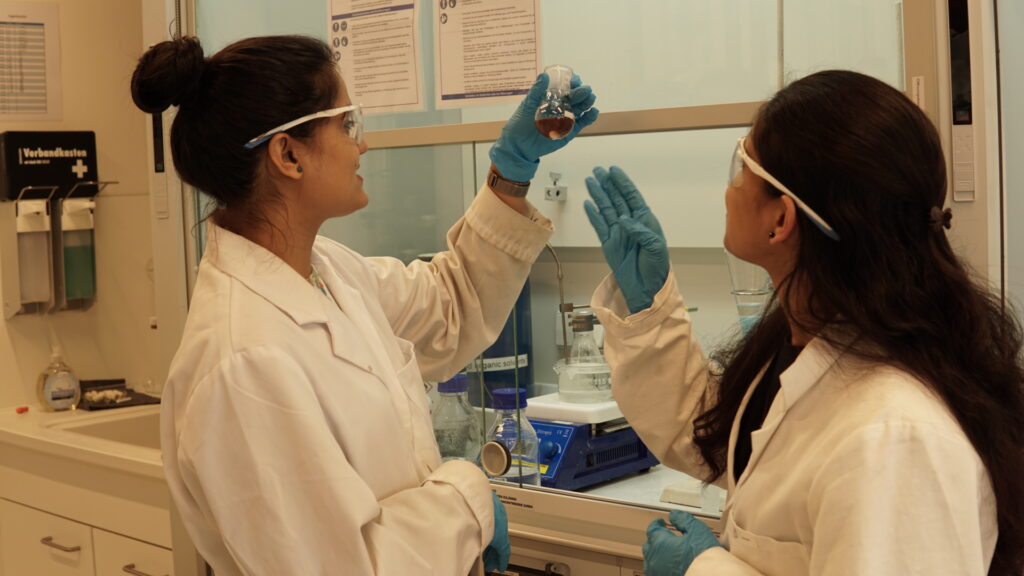HI:STORIES: Level Nine Nanozymes Spark Green Chemistry

Our modern society is profoundly dependent on the chemical industry. From the medicine we rely on to the food we eat and the technological devices that power our daily lives, much of what we take for granted stems from the industry’s contributions. Despite all the advantages chemical industry brings to our lives, it also presents serious challenges: its processes are often harmful to the environment and contribute significantly to climate change. This sector is energy-intensive, heavily reliant on fossil fuels, and is responsible for vast emissions.
Level Nine, a Berlin-based start-up founded by Emily Sheridan and Seadna Quigley, aims to change this trajectory. Emerging from the Humboldt-Innovation ecosystem, Level Nine develops specialized synthetic catalysts that could be transformative for a more sustainable chemical industry. These catalysts, known as nanozymes, emulate the functions of natural enzymes and can drive clean, efficient chemical reactions. With these catalysts, chemical firms can reduce – and potentially eliminate – their dependence on fossil fuels.
We spoke with Level Nine to learn more about their background, motivations, the role Humboldt-Innovation has played in their journey. We also discussed the significance of greener chemical industry and their perspectives on fostering innovation within the sector.
What is Level Nine?
We’re a Berlin-based deep-tech company working on synthetic catalysts called nanozymes that mimic nature’s most efficient molecular machines: enzymes. As such, Level Nine sits at the intersection of where innovative chemistry meets the possibility to unlock a new era of manufacturing. To understand our technology, its history must first be understood; nature has spent billions of years perfecting chemical reactions through enzymes, but these biological catalysts are frustratingly fragile and expensive to work for industry. So, we asked ourselves, what if we could capture their precision and efficiency in more robust, synthetic structures?
“Level Nine sits at the intersection of where innovative chemistry meets the possibility to unlock a new era of manufacturing.”
This venture means we’re not just tweaking existing industrial processes, we’re fundamentally reimagining how chemical reactions can happen. Using insights from computational chemistry and bio-nanoscience, we build catalysts from the ground up that are designed for both industrial performance and environmental responsibility.


Founders Emily Sheridan (CTO) and Seadna Quigley (CEO). (c) Level Nine.
How was it founded?
Level Nine was founded by Emily Sheridan (CTO), a recipient of the Women in Tech EU award and a PhD in Bio-Nanoscience from a globally leading institution, alongside Seadna Quigley (CEO), who has a proven track record of scaling impactful bioeconomy ventures such as Metabolic and Fresh Ventures.
What began as a research project into bio-inspired catalysis quickly evolved into a commercial venture as we realized the industrial potential of our work. Though explored in academic circles, we saw that nanozymes had never been translated into a robust, scalable platform for real-world chemical manufacturing.
With a blend of scientific rigour, entrepreneurial experience, and a deep understanding of industrial challenges, our two founders set out to build the world’s first company capable of deploying synthetic enzyme-like catalysts at commercial scale, which became Level Nine.
How did Humboldt-Innovation support Level Nine?
Through access to Humboldt’s extensive research ecosystem and expert network, we were able to sharpen our scientific foundations while exploring commercialization pathways in a structured, supportive environment. Their backing also helped us secure key partnerships and credibility in the Berlin innovation ecosystem that accelerated our transition beyond the lab bench.
Whilst operating in a city renowned for its scientific excellence and startup dynamism, working alongside Humboldt-Innovation served as a bridge that helped us take our breakthrough research to the next level.
“(…) working alongside Humboldt-Innovation served as a bridge that helped us take our breakthrough research to the next level.”
Their belief in our mission, especially during our very early stages, provided a confidence that affirmed the broader relevance of our work, and their support has continued to bolster our visibility and strategic development. In the early days, when you’re trying to convince investors and industry partners that your technology can work at scale, having Humboldt-Innovation’s backing sends a powerful signal.

What is the mission of your company?
Our mission is straightforward but ambitious: we want to help the chemical industry become part of the climate solution instead of the climate problem. Right now, global chemistry is responsible for massive carbon emissions (over 3 gigatons of CO₂ annually). As a society there is a great dependency upon this industry, from pharmaceuticals and materials, to food production and fuels. We can’t just shut it down, we need to transform it.
“(…) we want to help the chemical industry become part of the climate solution instead of the climate problem.”
That’s where our nanozymes come in. By developing catalysts that can drive clean, efficient chemical reactions, we’re giving companies the tools they need to move away from fossil-based processes without sacrificing performance or profitability. But our mission goes beyond just reducing emissions. We’re working toward a future where chemical manufacturing is decentralized, circular, and built around renewable feedstocks. Imagine chemical plants powered by agricultural waste instead of petroleum, or supply chains that regenerate resources instead of depleting them. That’s the transformation we’re trying to catalyze, literally and figuratively.
Why do we need a green chemical industry?
The chemical industry is everywhere, but its influence is easy to underestimate. The plastics in your phone, the fertilizers that grow your food, the medicines that keep you healthy: they all start with chemical processes. The industry touches virtually every aspect of modern life.
The problem is that most of these processes were developed decades ago when climate change wasn’t considered as urgently as it is today. The industry remains energy-intensive, heavily reliant upon fossil fuels, and produces enormous amounts of emissions – over 3 gigatons of CO₂ emissions per year, making it one of the largest contributors to global climate change. Now, as we race toward net-zero targets, chemistry has become one of the hardest and most-urgent sectors to decarbonize.
“(…) chemistry has become one of the hardest and most-urgent sectors to decarbonize.”
What excites us is the potential for positive impact. If we can unlock the potential of green chemistry, we don’t just reduce emissions but also enable entirely new ways of making things. We can turn agricultural waste into valuable chemicals, create materials that are designed for circularity from day one, and build manufacturing systems that actually strengthen rural economies. The urgency is real, but so is the opportunity. At Level Nine, we believe that by reinventing the very catalysts that drive chemical reactions, we can trigger a systemic change across the industry and transform it from a major emitter into a cornerstone of a regenerative economy.
What does innovation mean to you?
To us, innovation is the art and science of bridging what is possible with what is needed. It is about turning knowledge into solutions that are not only technologically advanced but also socially and environmentally relevant. In our field, innovation means taking abstract scientific concepts and translating them into tangible tools that solve industrial-scale problems; we spend a lot of time thinking about molecules that don’t exist yet, and then figuring out how to make them do exactly what we need them to do. To us, transforming concepts into reality is innovation in its purest form. It’s a process that requires courage, creativity, and collaboration. Innovation begins in the lab, but it must be validated in the real world and ultimately deliver impact that can be felt across markets and ecosystems.
“At Level Nine, innovation is built into our workflows, our culture, and our partnerships.”
Crucially, we see innovation as an iterative journey, not a destination. It’s about continually asking: how can we do this better, cleaner, faster, or more fairly? At Level Nine, innovation is built into our workflows, our culture, and our partnerships. It is the driving force behind every molecule we design and every solution we deploy. What keeps us going is knowing that every breakthrough in the lab gets us closer to catalysts that could transform entire supply chains. Innovation means staying curious, staying persistent, and never losing sight of the bigger picture.
Which role does innovation play within the chemical industry?
In the chemical industry, innovation is not optional – it is existential. As one of the most resource-and energy-intensive sectors globally, chemistry faces mounting pressure to evolve. Whether it’s reducing greenhouse gas emissions, replacing toxic reagents, or securing alternative feedstocks, innovation is the only path forward. Historically, much of the industry’s innovation has been incremental, whether optimizing existing processes or improving yields. But now the equation has changed. Companies need to hit sustainability targets, regulatory requirements are tightening, and customers are demanding cleaner products. Suddenly, incremental innovation isn’t enough and the challenges of the 21st century demand a step change: radical innovation that reimagines the fundamentals of chemical synthesis and production.
“In the chemical industry, innovation is not optional – it is existential.”
This is precisely where Level Nine operates. By introducing synthetic catalysts that emulate enzymes, we offer a new framework for chemical reactions that is inherently more selective, efficient, and sustainable. Our nanozyme technology is a perfect example of innovation meeting necessity: it not only outperforms traditional catalysts, but also addresses critical supply chain and sustainability challenges. The beautiful thing about working in such a foundational technology is the ripple effect. When you improve the catalysts that drive chemical reactions, you potentially improve every process that uses those reactions. A single breakthrough in our lab could influence how bio-based materials are produced or how renewable feedstocks are processed.
Thank you for the interview!
